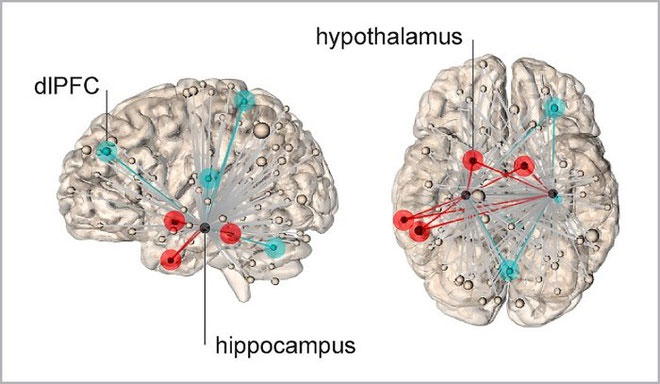Find stress 'hiding' stress locations in the brain
In our time, falling into negative emotions or stress states (inhibition, stress) is relatively common in life.
For stress, they can be divided into two types: physiological stress and emotional stress . When we have signs of physiological stress (also known as physiological suppression) which can be referred to as states of hunger, cold or pain, the hypothalamus of the brain will function to release the hormone glucocoticoids from adrenal glands, which help alleviate our unpleasant reactions.

The neural network comes from the hippocampus. The red lines show connections to the hypothalamus, predicting higher stress levels, while the blue lines indicate connections to the prefrontal cortex, the sign of lower stress. (Photo: Yale University).
For emotional stress, most of us have the misconception that negative feelings, pressure and anxiety are rooted in the mind.
However, unlike physiological stress, scientists have shown, the source of stress and inhibition emotions can come from a different location of the brain. There is ample evidence in both animals and humans that our stress mechanisms are linked to the hippocampus - a region of the brain that helps regulate memory, emotions and positioning. Even so, the link between hippocampus and stress is not really clear
In a recently published study, scientists from Yale University looked at how our brains work, providing a new perspective on how our bodies work.
The experiment, which was tested on 60 adults, showed scientists a series of unpleasant images associated with reactions such as disgust, fear or sadness, interspersed with them: The calm images help them relax.
After measuring the volunteers' brain activity signals using a magnetic resonance meter and ranking the levels they felt, the team found that the hypothalamus, hippocampus, and Thai cortex The positive and lower temples of the more intense participants will have a stronger signal of activity, forming a positive net.
In contrast, the hippocampus's connection to the prefrontal cortex, the posterior central and the cerebellum form a negative network, giving a stronger signal if the volunteers feel less stressed.

This finding could lead to new ways of treating stress in the future. (Photo: UT Dallas).
"Although these networks have a distinct role, our findings are likely to show that the networks that run the brains of the volunteers involved all try to reduce stressful feelings," the researchers said. science explained.
Basically, the level of volunteer stress is determined by the adaptive interaction between the two networks.
Although we still have many questions to answer about how hippocampus regulates stress, this discovery by scientists could open up new medical treatments in the future.
"These findings will help us to intervene in therapy for many subjects, such as increasing the strength of connections from the hippocampus to the frontal cortex or reducing the signal to physiological stress centers. " , says neuroscientist Rajita Sinha.
- Stress can make your brain smaller
- Detecting brain response mechanisms with stress
- Cats like to hide in boxes to reduce stress
- When stress should eat a lot
- Stress can be spread like a cold?
- 10 effects of stress and remedy
- A scary discovery in genetics
- 7 foods 'repel' stress
- Stress hormones alter brain tissue in mice
- Signs of stress
- Find medicine to erase sad memories
- Find out where to store fear memories in the brain
 13 causes of non-itchy rash
13 causes of non-itchy rash How the mouse with human ears changed the world?
How the mouse with human ears changed the world? The truth about 'fried rice syndrome!
The truth about 'fried rice syndrome! What is dental implant?
What is dental implant? 3 breathing exercises that are great for your lungs you should know
3 breathing exercises that are great for your lungs you should know  Why do we feel 'suffocated' when under pressure?
Why do we feel 'suffocated' when under pressure?  Social stress causes premature aging of the immune system
Social stress causes premature aging of the immune system  Virtual reality technology helps reduce stress for employees fighting Covid-19
Virtual reality technology helps reduce stress for employees fighting Covid-19  During the Covid-19 season, these people easily died of ... myocardial infarction
During the Covid-19 season, these people easily died of ... myocardial infarction  What doesn't kill you will make you much stronger
What doesn't kill you will make you much stronger 